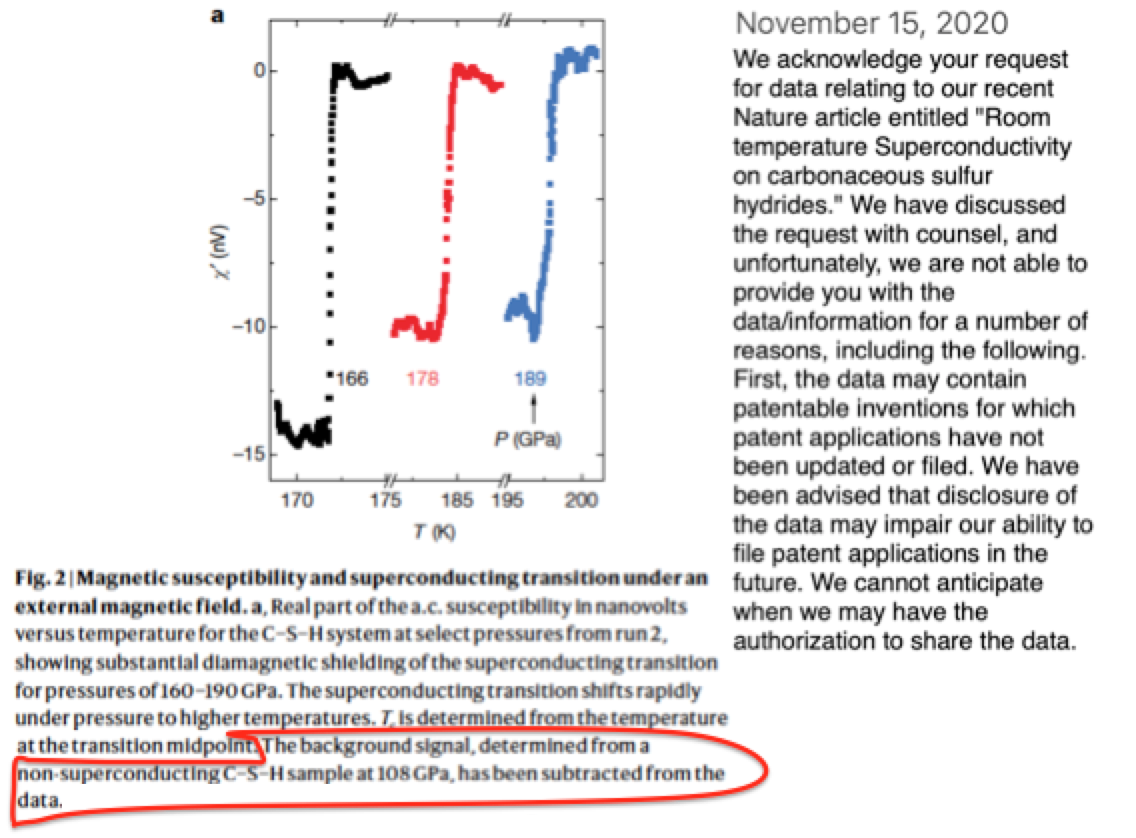 Return
Return
The data from the posted tables can be found here
We have analyzed these raw data and report on the result of this analysis in:
(1)
Preprints 2021, 2021120115
Disconnect between Published AC Magnetic Susceptibility of a Room Temperature Superconductor and Measured Raw Data,
This paper was submitted to the journal
Condensed Matter. It was reviewed by 4 referees, all of them recommended publication after minor changes. Subsequently, the Editors thought about it for more than 2 months, thereafter declined publication, on the grounds that
they came to the conclusion after "careful checking" that the paper
"does not report new experimental or theoretical results."
(2)
Preprints 2021, 2021120188
Incompatibility of Published AC Magnetic Susceptibility of a Room Temperature Superconductor with Measured Raw Data,
Nature declined to publish it as
"Matters Arising".
(3)
Preprints 2022, 2022010003, posted, then mysteriously withdrawn by preprints.org, pdf here:
Superconductivity in Carbonaceous Sulfur Hydride: Further Analysis
of Relation between Published AC Magnetic Susceptibility Data
and Measured Raw Data . Now
published in Europhysics Letters
(4)
arXiv:2201.07686
Comment on Nature 586, 373 (2020) by E. Snider et al.,
by D. van der Marel and J. E. Hirsch. Arxiv decided it has
"inflammatory content" and withdrew it.
(5)
Preprints 2022, 2022020005
Analysis Of Ac Magnetic Susceptibility Data Of A Room Temperature Superconductor,
by J. E. Hirsch (with D. van der Marel)
Arxiv had no objections to posting
arXiv:2111.15017v1
and
arXiv:2111.15017v2,
but refused to post our analysis
arxiv:submit/4062867
(now
Preprints 2021, 2021120115),
arxiv:submit/4066666
(now
Preprints 2021, 2021120188),
arxiv:submit/4102690
(now
in Europhysics Letters),
arxiv:submit/4143079
(now
Preprints 2022, 2022020005), and
arxiv:submit/4145039.
----------------------------------------------------------------------------------------------------------------------------------------------------------------------------------------------
Earlier history:
In Nature 586, 373 (2020), Snider et al announced the experimental discovery of room temperature superconductivity in a carbonaceous sulfur hydride under high pressure, hereafter called CSH. The paper reported sharp drops in the measured magnetic susceptibility as a function of temperature for five different pressures, that were claimed to be a superior test signaling a superconducting transition. Here I present several arguments indicating that the susceptibility data published in the paper were probably fraudulent. This calls into question the validity of the entire paper and its claim of detection of room temperature superconductivity. I also describe the roadblocks that I have encountered in reaching this conclusion. A variety of implications of this situation are discussed.